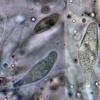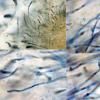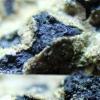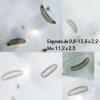
25-02-2018 15:08
 Jean-Louis JALLA
Jean-Louis JALLA
Bonjour à tous. Les Journées Mycologiques de Ha

24-02-2018 08:12
 Blasco Rafael
Blasco Rafael
Hola necesito de su ayuda para conocer esta especi

25-02-2018 09:05
Patrice TANCHAUDBonjourest-ce qu'il y a des conidies chez cette es

10-02-2018 19:05
Les exemplaires ne sont probablement encore compl�

23-02-2018 23:35
Valencia Lopez Francisco JavierHola a todos/asTengo estos pequeños ascos, recole

23-02-2018 17:58
 Andrew N. Miller
Andrew N. Miller
Do you recognize this conidium? Anything close t

22-02-2018 18:11
 Riet van Oosten
Riet van Oosten
Hello,Found by a friend: february 2018.On: Ribes n
En principio pense an alguna Tremellaceae, pero no veo nada parecido
Los apotecios, son como bolas de 1-2 mm. y tienen una consistencia dura hasta ronper, como pasa con la cascara de un huevo
A ver si hay alguna sugeencia
Saludos
Joseba
About the mushroom. yes, it's undoubtly a member of Tremellaceae. a Tremella sp. . According to recent advances in the knowledge of this Genus, all live as parasites on other fungi, especially Stereum, but on Pyrenomycetes too, like yours. (Diaporthe? Hypoxylon?) and are host-specific (species or genus).
Probably another member could add further informations, perhaps a species name.
Bien cordialement
Jacques
No te martirices por no haber aprendido Español, yo he estudiado durante años el Ingles y tampoco he conseguido aprenderlo´
He estado estudiando el hongo sobre el que esta parasitando y aunque solo he podido encontrar esporas en las 4 muerstras que he preparado, creo que lo que es claro es que se trata de un Diatrype, aunque no he podido localizar cual, porque las medidasa de las esporas que he tomado son demasiado grandes para los que yo conozco.
Pongo las fotos a ver si puedes ayudar a alguien a darme alguna pista
Saludos
Joseba
Buena tarde Joseba
For me, both pictures of the pyrenomycete are consistent with Diatrype stigma, rather than D. disciformis (forming "true" discs, and spores much smaller) althought the carpophores (ascomes) aren't confluent as yet. But for the Tremella, I'm unable to put a sp. name on it; perhaps somebody in the forum could help?
About Spanish, I refuse to use Google translator or anything like, just a dictionnary to translate words I do not understand. Spanish and Italian (and Portuguese) are alongside French latin-based languages, so I try to find out the root of each word (e. g. "martirice", I think has the same root than the french "martyr" with is stronger) and hence the meaning.
Bonne soirée
Cordialement
jacques
Saludos
Joseba
Hola Joseba,
I found the original description of Sirobasidium, from Brazil; I don't know if the fungus has since been described from elsewhere in the world: it has been recorded in UK, so... Your specimens grow obviously ON the Pyrenomycetes. The swollen hyphae ("bubbles") are consistent with Tremella, but not the spores (globose by Tremella)???
https://www.biodiversitylibrary.org/page/13076899#page/367/mode/1up
Sorry, no further idea...
Bonne soirée
Jacques






